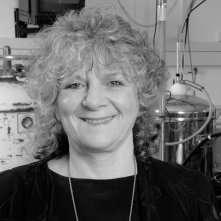October 7, 2009—The American Committee for the Weizmann Institute of Science congratulates Prof. Ada Yonath on receiving the 2009 Nobel Prize in Chemistry and is proud of her scientific achievements. We are delighted that the Nobel Committee for Chemistry has recognized the significance of Prof. Yonath's scientific research and awarded her this important prize.

Prof. Yonath's research is driven by curiosity and ambition to better understand the world and our place within it. This research aims high: to understand one of the most complicated "machines" of the biological system.
The announcement of the award is especially meaningful to and joyous for the American Committee for the Weizmann Institute. One of the Committee's most prominent leaders, Mrs. Helen Kimmel, together with her late husband, Martin, provided major funding for Prof. Yonath's research for more than 20 years. Prof. Yonath is the Martin S. and Helen Kimmel Professor of Structural Biology; her research is supported by the Helen and Milton A. Kimmelman Center for Biomolecular Structure and Assembly. The special friendship developed between Prof. Yonath and Mrs. Kimmel over the years symbolizes the Weizmann partnership between science and philanthropy.
In the late 1970s, Prof. Yonath decided, when she was a young student at the Weizmann Institute, to take on the challenge of answering one of the key questions concerning the activities of live cells: to decipher the structure and mechanism of action of ribosomes—the cell's protein factories. This was the beginning of a long scientific journey that has lasted decades, and required courage and devotion from the start. The journey began in a modest laboratory with a modest budget, and over the years increased to tens of researchers working under Prof. Yonath's guidance
This basic research, which began in an attempt to understand one of the principles of nature, eventually led to an understanding of how a number of antibiotics function, something that is likely to aid in the development of more advanced and effective antibiotics. This discovery will hopefully also help in the struggle against antibiotic-resistant bacteria, a problem recognized as one of the most central medical challenges of the 21st century.
Prof. Yonath can be considered a model of scientific vision for her courage in choosing a significant scientific question and devotion in realizing the goal to its end, which will hopefully broaden knowledge for the benefit of humanity.
BEYOND THE BASICS
"People called me a dreamer," says Prof. Ada Yonath of the Structural Biology Department, recalling her decision to undertake research on ribosomes—the cell's protein factories. Solving the ribosome's structure would give scientists unprecedented insight into how the genetic code is translated into proteins; by the late 1970s, however, top scientific teams around the world had already tried and failed to get these complex structures of protein and RNA to take on a crystalline form that could be studied. Dreamer or not, it was hard work that brought results: Prof. Yonath and her colleagues made a staggering 25,000 attempts before they succeeded in creating the first ribosome crystals in 1980.
And their work was just beginning. Over the next 20 years, Prof. Yonath and her colleagues would continue to improve their technique. In 2000, teams at the Weizmann Institute and the Max Planck Institute in Hamburg, Germany—both headed by Prof. Yonath—solved, for the first time, the complete spatial structure of both subunits of a bacterial ribosome. Science magazine counted this achievement among the ten most important scientific developments of that year. The next year, Prof. Yonath's teams revealed exactly how certain antibiotics are able to eliminate pathogenic bacteria by binding to their ribosomes, preventing them from producing crucial proteins.
Prof. Yonath's studies, which have stimulated intensive research worldwide, have now gone beyond the basic structure. She has revealed in detail how the genetic information is decoded, how the ribosome's inherent flexibility contributes to antibiotic selectivity, and the secrets of cross-resistance to various antibiotic families. Her findings are crucial for developing advanced antibiotics.
Prof. Ada Yonath's research is supported by the Helen and Milton A. Kimmelman Center for Biomolecular Structure and Assembly. Prof. Yonath is the Martin S. and Helen Kimmel Professor of Structural Biology. The Weizmann Institute of Science in Rehovot, Israel, is one of the world's top-ranking multidisciplinary research institutions. Noted for its wide-ranging exploration of the natural and exact sciences, the Institute is home to 2,600 scientists, students, technicians, and supporting staff. Institute research efforts include the search for new ways of fighting disease and hunger, examining leading questions in mathematics and computer science, probing the physics of matter and the universe, creating novel materials, and developing new strategies for protecting the environment.
